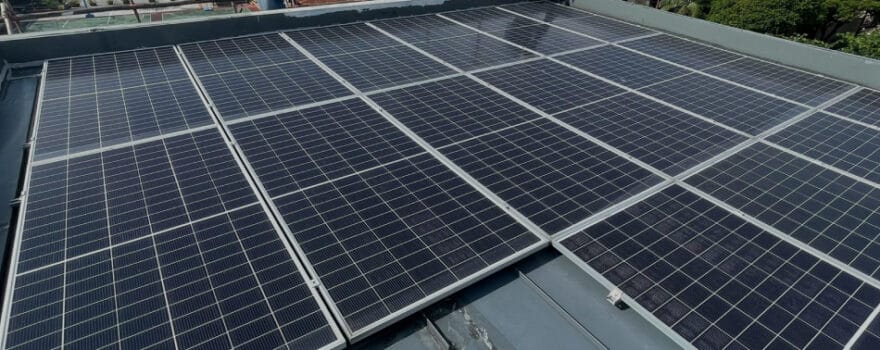
At First Solution Group, one of Singapore’s leading solar panel installation companies, we help homeowners and commercial clients optimise solar power for long-term energy efficiency. One rule of thumb we often recommend is the 20% Rule—a simple but powerful guideline to make your solar setup more resilient and cost-effective.
In this article, we’ll break down what the 20% Rule means, why it matters in Singapore’s tropical climate, and how you can apply it for your own home or business.
What Is the 20% Rule?
The 20% Rule for solar panels suggests that your solar energy system should be sized to produce 20% more electricity than your average monthly consumption. This extra buffer ensures your system stays effective during cloudy days, high-usage periods, or slight underperformance due to panel degradation or inverter losses.
Example:
If your household typically consumes 1,000 kWh per month, you should install a system capable of generating 1,200 kWh/month. That extra 200 kWh serves as your “solar safety margin.”
Why Add 20% Extra Capacity?
1. To Compensate for Singapore’s Weather
While Singapore enjoys abundant sunshine, we also experience frequent rain and cloud cover. Solar panels are less productive during overcast days. A 20% buffer ensures you don’t run short of energy and have to rely excessively on the grid.
2. To Cover Seasonal Usage Peaks
Air conditioning demand spikes during hotter months. For landed property owners, even a single inverter-based system running multiple AC units can cause unexpected surges. The extra capacity helps avoid power shortages during these months.
3. To Offset System Losses
No solar system operates at 100% efficiency. Common losses include:
-
Inverter losses: 3–7%
-
DC/AC conversion: ~5%
-
Cable and temperature losses: 2–3%
Combined, these losses can account for up to 15% of the system output—so planning for 20% extra makes technical sense.
4. To Future-Proof Your Investment
If you plan to add high-consumption devices like EV chargers, electric water heaters, or additional aircon units, the 20% rule prepares your system to accommodate this growth.
5. To Maximise Net-Metering Savings
In Singapore, if you’re under the SP Group’s Enhanced Central Intermediary Scheme, any excess solar energy sent back to the grid can earn credits. Overproduction is not wasted—it can offset night-time usage or reduce your next bill.
Is the 20% Rule Always Ideal?
It’s a rule of thumb—not a law. Here’s when adjustments may be needed:
-
Limited roof space: If you live in a terrace or semi-D with minimal usable roof area, you may not physically be able to add 20% extra panels. In such cases, consider high-efficiency modules (e.g., 450W–550W monocrystalline panels).
-
Shaded rooftops: Shade from neighbouring buildings or trees can reduce output. You might need more than 20% extra to compensate for shading losses.
-
Grid restrictions: In some developments, there may be cap limits on solar system export capacity. Always check with your local authority or speak with our engineers.
How to Apply the 20% Rule (Step-by-Step)
Step 1: Determine Your Average Monthly Usage
Refer to your SP Services bills over the last 12 months. Add the total kWh and divide by 12.
Example:
Total annual usage: 12,000 kWh → Monthly average: 1,000 kWh
Step 2: Add 20% Buffer
Multiply by 1.2.
1,000 kWh x 1.2 = 1,200 kWh
You now have your solar generation target.
Step 3: Calculate Required System Size
In Singapore, solar panels generate about 1,200–1,400 kWh per kWp per year.
So to generate 1,200 kWh/month = 14,400 kWh/year, divide:
14,400 ÷ 1,300 ≈ 11.1 kWp
Your home would need approximately an 11.1 kWp system.
Does the 20% Rule Refer to Solar Efficiency?
In some contexts, the term “20% rule” refers to panel efficiency—how much sunlight is converted into usable electricity.
-
A 20% efficient panel produces 200W for every 1,000W of sunlight received per m².
-
Modern bifacial or premium monocrystalline panels now reach 21–23% efficiency—ideal for rooftops with limited area.
Summary: Is the 20% Rule Right for You?
✅ It’s ideal for homes in Singapore, where weather variability, AC usage, and grid interaction make a compelling case for oversizing.
✅ It provides insurance against cloudy days, future upgrades, and daily variance.
✅ And it can help maximise your long-term ROI and energy savings.
However, it’s best used as a planning tool, not a rigid requirement. Your roof size, shading, inverter specs, and lifestyle all affect the right system sizing.
Let First Solution Group Design the Right Solar System for You
At First Solution Group, we specialise in solar panel installation for landed properties, bungalows, factories, and commercial buildings across Singapore. Our engineers will:
-
Conduct a free site assessment
-
Custom-size your system based on actual energy usage
-
Help you plan for future needs like EV charging or battery storage
-
Offer $0 upfront Rent-to-Own plans with full ownership at the end
🔧 Ready to optimise your rooftop with the 20% rule in mind?
📞 Contact First Solution Group today for a custom solar proposal tailored to your needs.